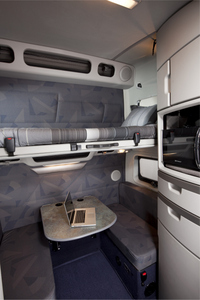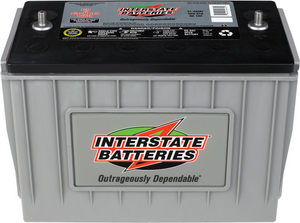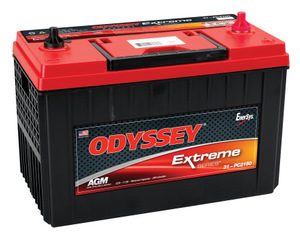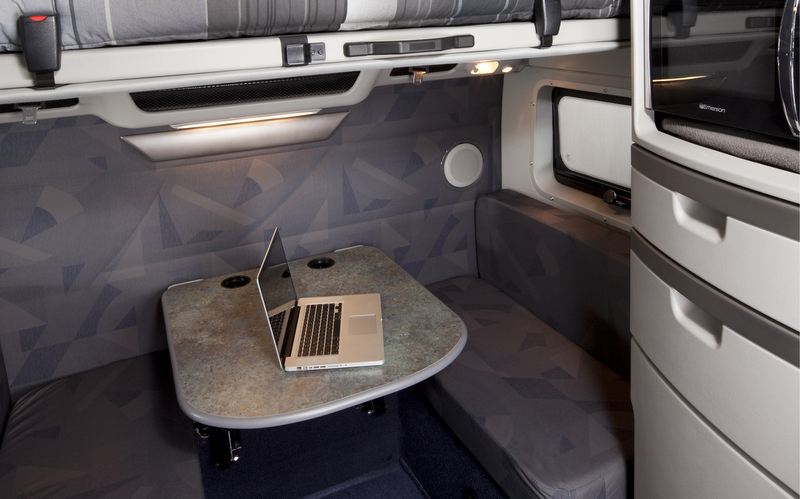
The demands placed on today’s fleets are staggering. In addition to increased efficiency demands on the mechanical side, computer systems, ECUs, GPS, iPhones, TVs, reefer units and countless other innovations tax the truck’s electrical system. The electrical demands are more than ever in history, and demand for voltage is not going away—it’s going to grow. Spec’ing the proper batteries for your fleet is the key to providing the productivity demanded of your equipment.
“I often call it a fifth-wheel motorhome because there are so many parasitics today,” says Gale Kimbrough, engineering and tech. services manager for Interstate Batteries, a Dallas-based company distributes automotive batteries, franchises and operates retail battery stores, recycles batteries, and provides motive and critical power products. Interstate sells more than 17 million batteries each year through its distribution network serving every county in the U.S., parts of Canada and Latin America. “When you shut that vehicle off, all those parasitics are still going. The difference is that there’s no charging to power them. So they’re all coming off the battery … As we get into various technologies, like going hybrid, if you will, the reliance on batteries will be more.”
Before you can get where you’re going, you have to know where you’re at—and that means taking a look at the battery demands of your fleet.
Battery basics
Some quick battery 101. There are two primary types of batteries being spec’d in trucks today—the classic flooded lead-acid and the newer absorbed glass mat, valve regulated lead acid (AGM-VRLA). The sealed AGM batteries eliminate the need to refill the electrolyte, while avoiding terminal corrosion and its surrounding area; from a generic standpoint, these batteries will hold a higher voltage during discharge and typically provide longer life, depending on the manufacturer, Kimbrough clarifies. On the flip side, they are also more expensive up front—up to two-and-a-half times more expensive.
“For AGM-VRLA batteries, like Odyssey Extreme Series batteries, the initial cost of the battery is more than offset by fewer battery failures and less frequent replacement, as well as a reduction in the time needed to maintain the fleet’s batteries,” says Grant Grunewald, EnerSys technical marketing manager, a Reading, Pa.-based manufacturer of stored energy solutions for automotive, military and industrial applications, with manufacturing facilities in 17 countries, sales and service locations throughout the world. “Saving money is a consideration in almost any buying situation. However, just because the initial cost of the battery is cheaper, doesn’t mean that it is the best deal. It is important to consider that fewer battery failures, less frequent replacement and little-to-no maintenance help save in the end.”
In addition to the flooded lead-acid/AGM choice, batteries are typically created with one of two main purposes in mind—starting power or deep cycle capacity. There are also batteries that aim to split the difference.
“With flooded, the more you shift to deep cycle, the more you may have to sacrifice some cold cranking amp [CCA] value in the battery,” Kimbrough explains. “Or the other way around—if you need 1,000 CCA for each battery, there’s little chance you’re going to have any deep cycling in that because you chose to go with a higher plate count inside an existing element.”
 CCA is defined by the amount of current a battery can provide at 0 degrees F for 30 seconds and it’s typically the most widely-used measurement for comparison. To find the battery that meets your fleet’s demands, you have to keep your equipment’s operation in the forefront. When you’re shopping around for batteries, evaluate the type of trucking you do: Are you a team driver or a single driver long hauler? Are you a regional day cab carrier? Do you run city delivery trucks that have to leave the lights on for deliveries for safety reasons but don’t run the engines? Do you have a large number of reefers? Lift gates?
CCA is defined by the amount of current a battery can provide at 0 degrees F for 30 seconds and it’s typically the most widely-used measurement for comparison. To find the battery that meets your fleet’s demands, you have to keep your equipment’s operation in the forefront. When you’re shopping around for batteries, evaluate the type of trucking you do: Are you a team driver or a single driver long hauler? Are you a regional day cab carrier? Do you run city delivery trucks that have to leave the lights on for deliveries for safety reasons but don’t run the engines? Do you have a large number of reefers? Lift gates?
Additionally, you also have to take into account what area of the country your usual routes take you through. Interstate, for example, offers a 950 CCA battery that has a reserve capacity of 195 min. that would fit for a truck that needs a high cranking ability in a cold environment. However, a 950 or 1,000 CCA battery might not be a good fit for a carrier consistently running southern routes through warm climates like Texas and Florida. It all comes down to: “Where are my batteries going to be and what depth of discharge do I normally get to?”
In assessing your equipment’s typical operation habits, you’ll be able to answer how much CCA you need, what you need in reserve power to run on-board accessories with the engine off and what you need in cycle life—shallow discharge for plenty of starting power or deep discharge for long hauls.
“A fleet manager should consider purchasing a battery that meets electrical load demands, has enough reserve capacity minutes to handle the parasitic load in the vehicle and that the alternator in the vehicle puts out enough amps with an appropriate voltage to recharge the batteries,” Grunewald recommends. “To prevent excessive discharge of the Odyssey Extreme Series batteries due to heavy parasitic loads such as when the vehicle is inactive for an extended time, it is recommended to connect the battery to an approved battery charger that puts out between 13.5V and 13.8V at the battery terminals. Physically disconnecting one of the battery cables is an alternate method to eliminate the drain. Again, always refer to the battery manufacturer’s recommendations when performing maintenance.”
Solid support, storage safety
You’ve spec’d the batteries, installed them properly and fleet operations are humming along smoothly. Everything is right in the world … until you get the call. A truck isn’t starting and its exhibiting dead battery symptoms. Whatever the case maybe—breakdowns happen. When batteries are concerned, you want to be sure that you have support from a company that offers the coverage that fits your fleet.
 Many battery manufacturers offer warranties on their products. Odyssey Extreme Series batteries, for example, include a two- to four-year warranty, based on the application, and a full replacement warranty from manufacturer’s defects, Grunewald says.
Many battery manufacturers offer warranties on their products. Odyssey Extreme Series batteries, for example, include a two- to four-year warranty, based on the application, and a full replacement warranty from manufacturer’s defects, Grunewald says.
Of course, every fleet manager wants to avoid the dreaded breakdown. As with many aspects of the truck, preventative maintenance goes a long way in improving your equipment’s uptime. Battery and electrical systems should be an integral part of any preventive maintenance inspection.
“I recommend doing a visual inspection—always check the open circuit voltage of those batteries. Make sure they’re clean. Even the cleanliness of batteries makes a tremendous difference,” Kimbrough says. “As you have dirt and residue that collects on top, you can lose power, in small quantities, across the top of the battery. Look at the cables, look check at all the connections—good, solid connections. You could also do a conductance check across the batteries. It’ll give you the voltage across the entire string and the total conductance value. That’s a simplistic way of checking that. and if that value is less than it should be for those batteries, it’ll signify that you need to check each battery individually.”
It is also important to follow the manufacturer’s specific maintenance recommendations as well to help extend battery life and keep cost of ownership down.
When a battery is on the shelf, be sure that the battery is properly charged before putting it into storage. Conventional batteries that are only partially charged when put into storage often experience permanent damage and may not recover to their full capacity, even if they are charged prior to reinstallation, explained Grunewald, who also pointed to the thin plate pure lead (TPPL) technology and proprietary designs and processes to highlight how EnerSys aims to overcome extremely deep discharge.
Some other quick storage do’s are:
• Always refer to the manufacturer’s recommendations when storing a battery.
• Fully charge the vehicle’s battery before placing it into storage to extend its service life.
• Test the battery to determine the battery’s state of charge.
• Store the battery in temperatures that meet the manufacturer’s recommendations.
“The lower the temperature, the longer the storage time, as long as the temperature does not drop below the manufacturer’s specifications. As a rule of thumb, an increase in temperature by approximately 18 degrees F can cut storage time in half,” Grunewald said. “Odyssey TPPL, AGM-VRLA batteries, for example, can be stored for two years or until the open circuit voltage [OCV] drops to 12 volts at temperatures of 77 degrees F or lower.”
Whether you’re storing or spec’ing, charging or maintaining, the correct batteries can help keep your fleet on the road and those productive parasitic loads powered.














